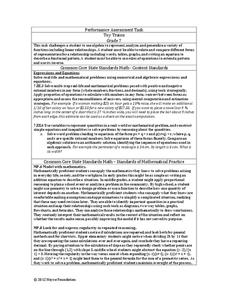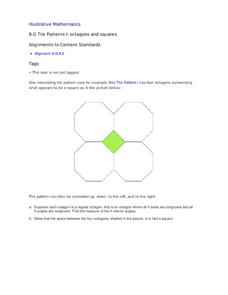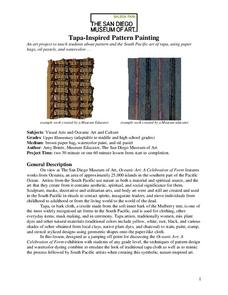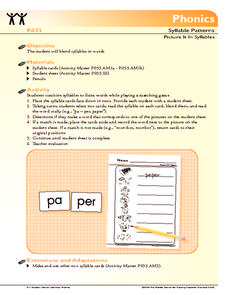Noyce Foundation
Toy Trains
Scholars identify and continue the numerical pattern for the number of wheels on a train. Using the established pattern and its inverse, they determine whether a number of wheels is possible. Pupils finish by developing an algebraic...
Curated OER
Tile Patterns I: Octagons and Squares
This can be used as a critical thinking exercise in congruence or as a teaching tool when first introducing the concept. Four octagons are arranged in such a way that a square is formed in the middle. With this information, geometry...
Virginia Department of Education
Balanced
Bring balance to your lesson plans with an activity that asks individuals to solve one-step linear equations with inverse operations. Balance scales help learners understand the concept of isolating the variable.
Curated OER
Patterns That Grow
Young scholars investigate growing patterns. In this additive patterns lesson, students analyze the core of growing patterns. Young scholars extend additive patterns based on the core.
Curated OER
Visual and Number Patterns
Fourth graders develop strategies for identifying geometric and number patterns. In this mathematical patterns lesson, 4th graders use pattern blocks to make repeating patterns with numbers and shapes. Students then explore number...
Curated OER
Making Patterns
Pupils utilize skittles and unifix cubes to practice the recognition and creation of a variety of patterns. The created patterns are copied onto sheets and the colors are labeled.
Curated OER
Working With Pattern Blocks
Fourth graders use pattern blocks to complete patterns, puzzle, and area centers. In this pattern blocks lesson plan, 4th graders also demonstrate fractions and use the SMART Board with their pattern blocks.
Curated OER
Geometric & Arithmetic Patterns
Eighth graders explore sequences. They discuss the difference between an arithmetic sequence and a geometric pattern. Students participate in workstation activities where they determine arithmetic or geometric patterns and predict the...
Curated OER
Rhythmic Pattern and Expressive Movement
Students use the song Row Row Row Your Boat to help them learn patterns and expressive movement. They recreate the movement over and over until it is a pattern and they feel comfortable doing it.
Curated OER
Rhythmic Pattern and Movement
Students practice repeating rhythmic patterns in unison. Next, students work in groups to practice an alternate rhythmic pattern to Row, Row, Row Your Boat. They create their own rhythmic patterns for the song.
Curated OER
Problem-Solving Strategy: Find a Pattern: Problem Solving
In this finding patterns instructional activity, students use the problem solving strategy of understand, plan, solve, and look back to help them find the pattern in the swimming distances numbers. Students use the pattern to help them...
Curated OER
Problem-Solving Strategy: Find a Pattern: Problem-Solving
In this finding patterns instructional activity, students read the word problem about costume costs and study the graph. Students then follow the steps of understand, plan, solve, and look back to find the pattern.
Curated OER
Patterns in Nature
In this patterns in nature learning exercise, students read about the Fibonacci Spiral, then follow the directions to plot one on the graph paper and draw the spiral, with links to more information.
Curated OER
Line and Pattern Design Paper Sculpture
The students create patterns and repeat colors for unity. They explore organic shapes and demonstrate awareness of design principles and art elements. They then create 3-D paper relief from a 2-D surface and demonstrate the difference...
Curated OER
Problem Solving: Find a Pattern
In this pattern worksheet, students complete a graphic organizer to help solve a problem following 4 steps: understand, plan, solve and look back. Houghton Mifflin text is referenced.
Curated OER
String 'Em Up
Students create different patterns using beads. They observe the teacher make patterns with different colored beads, identify the patterns, and create a necklace with colored beads, explaining what their pattern consists of to the class.
American Museum of Natural History
Make Your Own Weather Station
Scholars build a weather station equipped with a wind vane, rain gauge, and barometer. Following an informative page about the weather, learners follow steps to build their pieces then turn into meteorologists to chart the weather they...
Curated OER
Extend a Pattern
In this color blocks worksheet, young scholars explore patterns and sequences. Students determine the number of combinations that can be made before they repeat. This one-page worksheet contains 1 multi-step problem.
Curated OER
Counting to 100: Step-by-Step
Introduce your pupils to the hundreds chart! This pair of worksheets is designed to walk them through the patterns they see in the chart as they count by ones and 10s. They fill in missing numbers on a hundreds chart, using guided steps....
Curated OER
Color Kaleidoscopes
Students construct kaleidoscopes to demonstrate how an image is multiplied by angled mirrors before light rays reach their eyes. They follow step-by-step directions to create a kaleidoscope, and draw illustrations of the repeating...
Curriculum Corner
Be a Speed Reader
Young learners speed their way toward fluent reading with a hands-on consonant digraph activity. Using the numbered grid included in this resource, children roll a die and choose a word corresponding to the number they rolled. They then...
San Diego Museum of Art
Tapa-Inspired Pattern Painting
Middle schoolers are encourage to try their hand at traditional Oceania tapa art by crafting their own cloth using brown paper bags. Included in the resource is background information about the cultures of Oceania and their art.
Florida Center for Reading Research
Phonics: Syllable Patterns, Picture It In Syllables
Scholars practice blending syllables by playing a matching game. Pairs flip two cards and blend syllables; if they create a word, the player writes it on a worksheet; if not, the cards return to the collection.
EngageNY
Multiplying and Factoring Polynomial Expressions (part 2)
If you can multiply binomials, you can factor trinomials! This is the premise for a instructional activity on factoring. Pupils look for patterns in the binomials they multiply and apply them in reverse. Examples include leading...

























